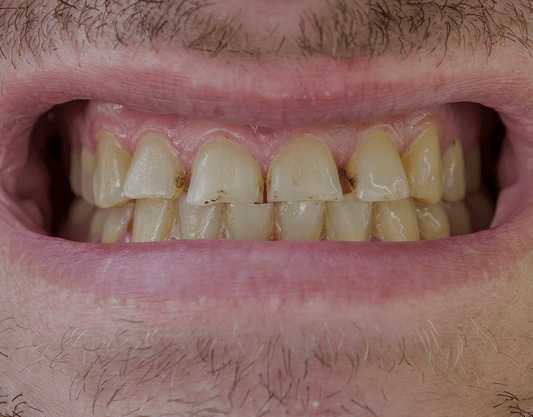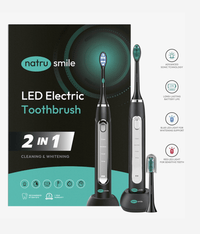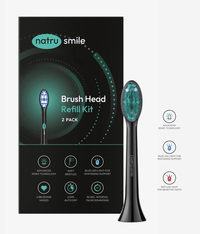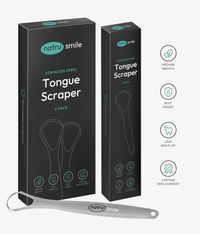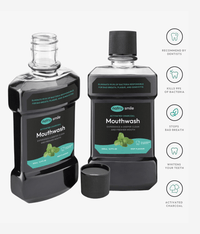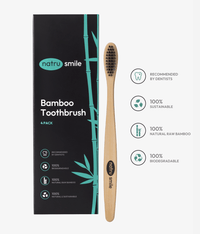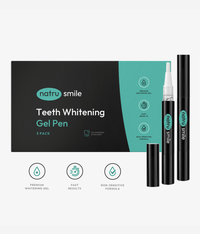
All products are certified by dental expert Dr. Greg Grillo
Now, people spend billions on teeth whitening procedures and products.
For some, white teeth are a status symbol or source of confidence. For others, it’s a matter of personal hygiene.
In some cases, teeth whitening is a restorative measure, helping people get their appearance back to normal after years of habits like smoking and poor dental care.
But what causes tooth discoloration and staining in the first place?
Natural human teeth occur in varying shades of yellow, but significant discoloration or uneven coloring can be caused by certain lifestyle factors and medical conditions.
In this article, we'll take a look at everything that can lead to tooth discoloration and staining, as well as provide tips on how to keep your teeth looking their best.
Types Of Tooth Discoloration And Staining
The first step in understanding what causes tooth discoloration and staining is to break down the types.
There are two main forms of tooth discoloration: intrinsic (inside the tooth) and extrinsic (on the surface). Tooth discoloration can also be age-related.
Intrinsic Tooth Discoloration
Intrinsic tooth discoloration is internal staining of the teeth. It's caused by changes in the mineral structure of the enamel or dentin—the two outer layers of a tooth—or by changes in the color of the pulp inside.
Intrinsic discoloration is usually caused by internal problems and side effects, including:
- Fluorosis (excessive exposure to fluoride)
- Certain illnesses, like cancer, heart disease, and diabetes
- Some medications, including antibiotics and antihistamines
- Trauma to the teeth or oral injury
Intrinsic discoloration is often the result of untreated oral hygiene problems. When extrinsic discoloration and untreated dental problems (e.g., dental caries) go untreated, they can cause cracks in the teeth, which give way to intrinsic discoloration.
Since it forms under the tooth's surface, intrinsic discoloration can be tricky to handle. In-office teeth whitening is usually required to treat them, although some at-home products may also suffice.
Extrinsic Tooth Discoloration
Extrinsic teeth stains are usually the first thing people think of when they hear the term "tooth discoloration." They're caused by external agents that attach themselves to the surface of the teeth, such as plaque and tartar buildup.
Extrinsic discoloration is typically caused by external or self-inflicted factors, such as:
- Smoking and chewing tobacco
- Drinking coffee, tea, or red wine
- Food or drinks with dark pigments, such as beets and tomato sauce
- Certain medications, such as tetracycline and iron supplements
- Unhealthy oral hygiene habits, such as not brushing regularly
Since extrinsic stains are on the surface of the teeth, they can often be treated with teeth whitening kits that can be bought over the counter. But the effectiveness of any teeth whitening solution on extrinsic stains depends on the severity of the case.
Age-Related Tooth Discoloration
As people age, the likelihood of them developing some discoloration on their teeth is much higher. This is because, with age, the enamel on our teeth begins to thin out, making it more susceptible to discoloration and staining.
There are several factors contributing to this:
- Continuous exposure to acidic, tannic, sugary, and pigmented substances over decades
- A gradual decrease in saliva production, which can lead to mineral deficiencies
- Weakened ability to fight off tooth-attacking bacteria
96% of seniors (i.e., those over 65 years old) have had a cavity, and one in five has untreated tooth decay. The lack of routine dental care accompanied with natural aging speeds up the yellowing process as people age.
Over time, these stains also become more permanent. Many older individuals begin to notice black stains on their teeth and uneven discoloration beneath the tooth's surface.
8 Common Causes Of Tooth Discoloration And Stains
There are numerous factors that contribute to tooth staining and discoloration. Some of them are preventable, while others are out of our control.
Here are some of the most common causes of tooth discoloration and stains.
Food And Beverage
There are several foods and drinks that damage teeth, and many of them are foods we eat every day.
Common culprits of tooth discoloration and staining include:
- Beverages with tannins, including red wine, coffee, and cark-colored teas
- Citrus fruits like oranges, lemons, limes, and grapefruits
- Starchy foods like bread, crackers, and chips
- Tomatoes and tomato-based products like ketchup and pizza sauce
- Hard and gummy candies
- Carbonated beverages like beer, soft drinks, and energy drinks
- Vinegar-based salad dressings and marinades
Of course, most of these foods can't realistically be avoided. They are mostly food and beverage items that are delicious, and some play significant roles in a balanced diet, despite their potential to cause stains.
That's why proper oral care is so important. Brushing and flossing routinely can help reduce the discoloration caused by these foods.
Tobacco And Nicotine Use
The relationship between smoking and teeth problems is heavily studied, and the results are always the same: tobacco and nicotine use is bad for your oral health.
More than 26% of adults have untreated tooth decay, and smoking increases the risk of developing cavities, gum disease, and other dental problems by a huge margin. It also causes sticky plaque buildup on the teeth and a stained tongue.
For those who are lucky enough to not have any major oral health problems from smoking, yellow teeth are a more immediate issue. Smoking and chewing tobacco cause direct stains on the teeth, some of which are harder to remove than extrinsic ones from other sources.
In extreme cases, smokers may even experience a permanent gray discoloration of the enamel.
For those who have quit smoking, vaping is also problematic. The nicotine and other compounds in e-cigarettes are still major contributors to discoloration.
Age
As previously mentioned, age has a lot to do with susceptibility to tooth discoloration. Teeth become more porous as people age, making it easier for stains to take hold.
Seniors may also struggle with weakened saliva production and mineral deficiencies, both of which increase the chances of discoloration.
It's important for older individuals to focus on preventive measures like brushing and flossing regularly, using special mouthwashes, and scheduling regular visits for dental cleanings and check-ups.
Injuries
Tooth injuries like chips, cracks, and breaks can increase the likelihood of discoloration under the enamel. A chipped tooth can expose a vulnerable part of the tooth to food and bacteria, which can cause discoloration over time.
A broken or cracked tooth may also lead to internal bleeding in the gums or root canal infection that causes further discoloration and staining.
The best way to prevent this is by wearing a mouthguard when playing sports and avoiding hard foods that can cause tooth fractures.
Medications
Some medications can lead to discoloration of the teeth over time. Many antibiotics, for example, contain compounds like tetracycline and doxycycline that offer effective protection against bacterial infections but also stain the teeth in the process.
In addition, certain medical conditions require long-term treatments with drugs that could lead to discoloration of the teeth. For instance, high blood pressure medications like ACE inhibitors and diuretics may cause a yellowish tint on the enamel.
Poor Dental Hygiene
Neglecting proper oral care is the most common and easily avoidable cause of tooth discoloration.
Not brushing and flossing regularly gives bacteria a chance to accumulate on the surface of the teeth, leading to plaque buildup and eventual yellowing.
A few essential steps can go a long way in preventing discoloration. Brush your teeth twice each day with fluoride toothpaste, floss once daily to remove plaque, and use mouthwash to further reduce bacteria buildup.
Consulting with a dental professional on a regular basis is also important for maintaining healthy teeth and gums and catching any potential problems early. Dental appointments don't take long and are worth the effort in the long run.
Genetics
Those with genetic conditions such as dentinogenesis imperfecta and amelogenesis imperfecta may experience gray or yellow-brown staining of the teeth.
Such discoloration can also cause the teeth to become transparent, weak, brittle, and pittable, increasing susceptibility to decay, chipping, and fracturing.
It is important to note that even without having these specific conditions, people can still have genetic predispositions for stained teeth—this can be passed on from generation to generation.
Still, these occurrences are rare and can be managed with preventive measures like regular dental check-ups and good oral hygiene habits.
Certain Illnesses
Some illnesses can cause teeth discoloration. For instance, kidney and liver diseases may lead to a buildup of toxins in the body that are then secreted through saliva, leading to yellowing of the enamel.
Having too much fluoride in the body can also manifest itself as white spotted stains on the teeth.
Teeth Staining Summary By Color
Depending on the type of staining you have, it could mean different things. Let's take a look at different color stains on the teeth and what they generally mean.
Black
Your teeth probably won't turn completely black. But black spots on teeth are entirely possible and they can quickly turn into black patches as well.
Typically, black spots on your teeth are the result of tooth decay—bacteria eat away at the enamel and leave behind dark spots.
If you find black spots on your teeth, you will probably have other signs of decay as well, such as bad breath and increased tooth sensitivity.
Yellow
Teeth are naturally a yellow shade, but if you notice your teeth getting darker, it could be the result of staining from smoking, red wine, coffee, tea, or sugary foods.
It could also mean that you're not brushing and flossing enough and that bacteria have settled into your teeth and caused them to darken.
Yellow teeth are fairly common—38% of people consider their teeth to be yellow, according to a recent DentaVox survey.
Getting rid of yellow teeth is usually fairly straightforward, and yellow teeth aren't usually cause for concern.
However, if you think your yellow teeth could be a sign of something else, such as disease or medication side effects, it is important to speak to your dentist about it.
Brown
Besides yellow teeth, brown are another common discoloration. Just like many other discolorations, brown spots on your teeth could mean that you aren't brushing and flossing enough or that you are consuming too much dark-colored drinks such as coffee and wine.
Typically, brown stains are caused by surface staining, meaning you can remove brown stains with professional teeth whitening treatments like bleaching and laser whitening.
White
Bright white teeth are usually the result of bleaching or at-home whitening treatments. But if your teeth have a "chalky" white discoloration, it could be a sign of fluorosis or other medical conditions.
The good news is that white spots on teeth usually don't require any special treatment and can be managed with regular dental hygiene practices.
Purple Or Grey
If you notice your teeth turning purple or grey, it could be a sign of nerve damage, trauma to the tooth, or that your tooth is dying or dead.
This form of discoloration typically happens to people who have had tooth trauma or have undergone some form of dental work.
It is important to get these issues checked out by your dentist as soon as possible—the sooner you act, the better your chances of saving the tooth and avoiding serious complications down the line.
How To Remove Almost Every Type Of Tooth Discoloration
Regardless of the type of discoloration you have, there are numerous ways to fix it.
Your dentist can typically remove surface stains, even in the most serious of cases. In many instances, however, this isn't even necessary.
In-Chair Treatment
Professional teeth whitening is your best bet if you want to get rid of deep stains, as it involves using a special bleaching gel or laser.
With laser teeth whitening or bleaching treatments, you'll see significant results after your first visit. And after a two or three, you'll have long-lasting whiteness that is noticeably different.
Just about everyone suffers from tooth sensitivity after professional teeth whitening, but this usually fades within a couple of days. It can also be cost-prohibitive, but if teeth whitening cost isn't an issue then it's by far the safest and most effective option.
Over-The-Counter Products
If you don't want to spend money on at-home whitening treatments, there are over-the-counter products that can help remove surface stains. These include whitening toothpaste, whitening strips, and mouth rinses. Unfortunately, these take time to work (and some don't work as well), so you won't see immediate results.
However, if used regularly they will be effective in removing surface stains and preventing new ones from forming.
It is important to note that over-the-counter products are only safe when used as directed. And without dental supervision, the likelihood of misuse is much higher.
At-Home Treatments
If you're looking to save money, there are some simple natural teeth whitening methods that can help prevent and reduce surface stains.
These include brushing regularly with a homemade baking soda paste, using hydrogen peroxide mouthwash, oil pulling with coconut or olive oil, and eating foods like apples that are known to naturally whiten teeth.
When looking into at-home treatments, remember that some don't work. Activated charcoal, for example, is very abrasive and can actually cause more damage.
The same is true for lemon juice and apple cider vinegar—they're too acidic and can damage tooth enamel.
8 Ways To Prevent And Reduce Tooth Stains
The best way to fight tooth discoloration is to take preventive measures and avoid it altogether. Here are some useful tips to keep in mind:
1. Brush Your Teeth After Every Meal.
Brushing twice daily is enough to keep your teeth healthy, but brushing after each meal will prevent food particles and plaque from building up on your teeth.
Research also shows that brushing your teeth more often can fight against heart disease, a condition closely related with overall oral health.
If you choose not to brush your teeth when you're supposed to, the consequences are also dire—you can increase your risk of developing cavities, gum disease, and eventually tooth loss.
2. Check Your Plaque Quotient.
To reveal the areas where plaque still lingers after brushing, rinse with a disclosing solution from your dentist. If you don't enhance your brushing technique in these places, they will be at much higher risk of developing stains.
To capture plaque in hard-to-reach places, floss your teeth at least once a day, and consider using an interdental brush or water flosser for even better results.
3. Ditch Your Bad Habits.
A lot of the habits that damage your teeth are also bad for other aspects of your health.
Here are a few good places to start:
-
Eat tooth-friendly foods. A diet rich in calcium and vitamin D and low in sugar, starch, and other processed foods will protect your smile. Foods like apples and celery are also great for naturally whitening teeth.
-
Say no to smoking and vaping. Smoking stains your teeth, weakens your gums, and reduces the oxygen in your blood. Vaping is just as bad—the chemicals found in e-cigarettes have been linked to tooth decay.
-
Drink water throughout the day. Not only does this help reduce surface stains and prevent dehydration, but it also helps flush away particles of food stuck in the teeth.
- Use a straw for sugary drinks. When you drink through a straw, the liquid bypasses your front teeth and goes straight to the back. This will help reduce staining on your front teeth.
Most of these changes are ones you can start today. They’re simple steps to take that can help you reduce your chances of developing tooth discoloration and stains.
4. Use Mouthwash Often.
Mouthwash is perfect for preventing and reducing stains on your teeth. It helps dislodge trapped food particles and bacteria, and it also washes away plaque.
Especially in between meals and at times where you don't feel like brushing, mouthwash is an excellent way to keep your teeth and breath fresh.
5. Switch To An Electric Toothbrush.
According to numerous studies, electric toothbrushes are more effective at removing plaque. They also provide superior protection against cavities, gingivitis, and other oral health issues.
Electric toothbrushes are better for plaque removal because they provide an oscillating or rotating motion that is more effective at removing plaque than manual brushing.
This motion gives the bristles of the brush a greater reach, cleaning in areas that would otherwise be hard to get to with manual brushing.
Electric toothbrushes also come with features such as adjustable modes, timers, and pressure sensors that help ensure proper technique and maximum plaque removal. These features allow users to customize their experience for a deeper clean and increased protection against cavities and gingivitis.
6. Use Whitening Toothpaste.
Whitening toothpaste is a great way to reduce surface stains on your teeth. It contains small amounts of hydrogen peroxide, which helps to break down stain-causing particles in the enamel and make your teeth look brighter.
It’s important to remember that whitening toothpastes only work on surface stains—they won't do much for deep-seated discoloration. For deeper staining, you may need to consider professional whitening treatments.
You should also remember that whitening toothpaste isn't your everyday toothpaste. Since it is abrasive, you'll want to use it for about a month or two and then switch back to your regular toothpaste to avoid tooth damage or sensitivity.
7. Try Teeth Whitening Strips.
Of all the at-home whitening products, teeth whitening strips are probably the most popular. These thin strips are coated on one side with a whitening gel that contains hydrogen peroxide or other bleaching agents.
You place the strip on your teeth, pressing it gently against the surface to get maximum contact between the gel and your enamel.
Usually, you'll wear them for about 30 minutes a day over a period of two to four weeks.
Teeth whitening strips are a great option for those who want to achieve a brighter smile without breaking the bank. Most of them cost under $100 and can be purchased at your local pharmacy or online.
8. Use A Bleach Tray.
Your dentist may also recommend using a bleach tray as part of your teeth whitening routine.
These trays are custom-made to fit your upper and/or lower teeth and contain a bleaching agent such as hydrogen peroxide, carbamide peroxide, or sodium hypochlorite.
You’ll wear the tray for up to an hour each day, usually for two to four weeks. The bleaching agent in the tray helps to break down surface stains and discoloration, leaving your teeth brighter and whiter.
The Bottom Line
There are plenty of ways to get rid of discoloration and stains on your teeth, even if you aren't able to invest in professional whitening treatments.
By following these simple tips, you can help keep your teeth looking their best and prevent tooth discoloration in the future.
Still, if you're seeing signs of deep staining or discoloration, it's best to consult your dentist for advice on how to address them.
Want to learn more? Here are the questions our customers ask us the most.
Can A Discolored Tooth Turn White Again?
If you have yellow or discolored teeth, the good news is that you can still improve your smile. In-office teeth whitening is the safest and most effective way to do this, but you can also opt for at-home whitening kits or trays for a more gradual, wallet-friendly approach.
Does Tooth Discoloration Go Away?
Tooth discoloration may be a temporary side effect of certain foods, drinks, medications, and lifestyle choices. But it won't go away on its own. In simple cases, regular dental care (i.e., brushing, flossing, and mouthwash) will be enough to make a difference. But if you smoke, drink coffee, or have deep discoloration from years of staining, you may need to invest in professional whitening treatments or specialized whitening products.
Why Are My Teeth Suddenly Discolored?
There are a few things that can cause sudden tooth discoloration:
- Pigmented foods and drinks like coffee, tea, and red wine
- Certain medications that can cause staining or yellowing
- Smoking
- Trauma to your teeth that causes blood vessels to burst in the pulp chamber
- Dead or dying tooth pulp
If you notice sudden discoloration, it's best to consult your dentist for advice, especially if your tooth/teeth turn grey or black.
Is Tooth Discoloration Normal?
Many people believe that their yellowish teeth are discolored. The reality is that white teeth aren't usually natural—the pearly white teeth you see on the internet are usually the result of professional whitening and bleaching treatments.
But if you want to keep your teeth looking their best, it's important to take care of them by brushing and flossing regularly and using the right products (i.e., toothpaste that’s designed for sensitivity or whitening).
At What Age Do Teeth Discolor?
Your teeth can discolor at any age, but the risk is higher as you get older. This is because the enamel on your teeth starts to wear away with age, exposing the softer dentin layer underneath. As this layer gradually wears away, it will start to show through as yellow or brown discoloration.
Additionally, lifestyle habits such as smoking and drinking coffee can also contribute to discoloration as you get older.
How Can I Fix Discolored Teeth At Home?
There are several teeth whitening options for those looking for at-home solutions to teeth whitening:
- Over-the-counter whitening strips and gels
- Whitening toothpastes
- Professional at-home whitening trays
- Natural whitening methods
No matter which option you choose, make sure to follow the directions carefully and speak to your dentist if you experience any pain or discomfort.
What Do Discolored Teeth Look Like?
If your teeth look black, grey, yellow, or brown, or have a blue or purple hue, you may be experiencing some degree of tooth discoloration.
It can vary from person to person, but typically darker colors are associated with deeper staining and more serious discoloration.
What Illness Causes Teeth Discoloration?
There is a long list of conditions that exacerbate or cause teeth discoloration, including:
- Diabetes
- Tuberculosis
- Kidney disease
- Liver disease
- Vitamin deficiencies
- Acid reflux
- Leukemia
- Gum disease and other oral health problems
Can Vitamin Deficiency Cause Tooth Discoloration?
Yes, vitamin deficiency can cause tooth discoloration. Vitamin deficiencies can lead to a variety of dental issues, including tooth discoloration. Tooth discoloration caused by vitamin deficiency is usually yellow or brown in color, and may appear as spots or lines on the outer enamel layer of your teeth. Vitamins play
Can Liver Disease Cause Teeth Discoloration?
Yes, liver disease can cause tooth discoloration. The toxins created by the diseased liver are secreted into the saliva and can be absorbed by your teeth. This leads to discoloration of your teeth in the form of yellow or brown spots on the surface of your enamel.

